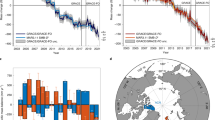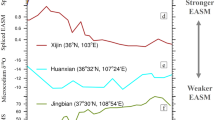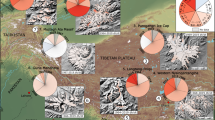Abstract
Glaciers in High Asia store large amounts of water and are affected by climate change. Efforts to determine decadal-scale glacier change are therefore increasing, predicated on the concept that glaciers outside the northwest of the mountain system are controlled by the tropical monsoon. Here we show that the mass balance of Zhadang Glacier on the southern Tibetan Plateau, 2001–2011, was driven by mid-latitude climate as well, on the basis of high-altitude measurements and combined atmospheric–glacier modelling. Results reveal that precipitation conditions in May–June largely determine the annual mass-balance, but they are shaped by both the intensity of Indian summer monsoon onset and mid-latitude dynamics. In particular, large-scale westerly waves control the tropospheric flow strength over the Tibetan Plateau remotely. This strength alone explains 73% of interannual mass-balance variability of Zhadang Glacier, and affects May–June precipitation and summer air temperatures in many parts of High Asia’s zone of monsoon influence. Thus, mid-latitude climate should be considered as a possible driver of past and future glacier changes in this zone.
This is a preview of subscription content, access via your institution
Access options
Subscribe to this journal
Receive 12 print issues and online access
$209.00 per year
only $17.42 per issue
Buy this article
- Purchase on Springer Link
- Instant access to full article PDF
Prices may be subject to local taxes which are calculated during checkout





Similar content being viewed by others
References
Kaser, G., Großhauser, M. & Marzeion, B. Contribution potential of glaciers to water availability in different climate regimes. Proc. Natl Acad. Sci. USA 107, 20223–20227 (2010).
Bolch, T. et al. The state and fate of Himalayan glaciers. Science 336, 310–314 (2012).
Marzeion, B., Jarosch, A. H. & Hofer, M. Past and future sea-level change from the surface mass balance of glaciers. Cryosphere 6, 1295–1322 (2012).
Mölg, T., Maussion, F., Yang, W. & Scherer, D. The footprint of Asian monsoon dynamics in the mass and energy balance of a Tibetan glacier. Cryosphere 6, 1445–1461 (2012).
Scherler, D., Bookhagen, B. & Strecker, M. R. Spatially variable response of Himalayan glaciers to climate change affected by debris cover. Nature Geosci. 4, 156–159 (2011).
Yao, T. et al. Different glacier status with atmospheric circulations in Tibetan Plateau and surroundings. Nature Clim. Change 2, 663–667 (2012).
Gardelle, J., Berthier, E., Arnaud, Y. & Kääb, A. Region-wide glacier mass balances over the Pamir–Karakoram–Himalaya during 1999–2011. Cryosphere 7, 1263–1286 (2013).
Kääb, A., Berthier, E., Nuth, C., Gardelle, J. & Arnaud, Y. Contrasting patterns of early twenty-first-century glacier mass change in the Himalayas. Nature 488, 495–498 (2012).
Bolch, T. et al. A glacier inventory for the western Nyainqentanglha Range and the Nam Co Basin, Tibet, and glacier changes 1976–2009. Cryosphere 4, 419–433 (2010).
Fujita, K. & Ageta, Y. Effect of summer accumulation on glacier mass balance on the Tibetan Plateau revealed by mass-balance model. J. Glaciol. 46, 244–252 (2000).
Zhang, G. et al. Energy and mass balance of the Zhadang Glacier surface, central Tibetan Plateau. J. Glaciol. 59, 137–148 (2013).
Mölg, T., Cullen, N. J., Hardy, D. R., Winkler, M. & Kaser, G. Quantifying climate change in the tropical mid-troposphere over East Africa from glacier shrinkage on Kilimanjaro. J. Clim. 22, 4162–4181 (2009).
Mölg, T. & Kaser, G. A new approach to resolving climate-cryosphere relations: Downscaling climate dynamics to glacier-scale mass and energy balance without statistical scale linking. J. Geophys. Res. 116, D16101 (2011).
Mölg, T., Großhauser, M., Hemp, A., Hofer, M. & Marzeion, B. Limited forcing of glacier loss through land-cover change on Kilimanjaro. Nature Clim. Change 2, 254–258 (2012).
Park, H. S., Chiang, J. C. H., Lintner, B. & Zhang, G. J. The delayed effect of major El Nino events on Indian Monsoon Rainfall. J. Clim. 23, 932–946 (2010).
Wu, G. et al. Thermal controls on the Asian summer monsoon. Sci. Rep. 2, 404 (2012).
Aizen, V. B., Aizen, E. M., Melack, J. M. & Dozier, J. Climatic and hydrologic changes in the Tien Shan, Central Asia. J. Clim. 10, 1393–1404 (1997).
Chen, F. et al. Holocene moisture evolution in arid central Asia and its out-of-phase relationship with Asian monsoon history. Quat. Sci. Rev. 27, 351–364 (2008).
Bothe, O., Fraedrich, K. & Zhu, X. Large-scale circulations and Tibetan Plateau summer drought and wetness in a high-resolution climate model. Int. J. Climatol. 31, 832–846 (2011).
Ding, Q. & Wang, B. Circumglobal teleconnection in the northern hemisphere summer. J. Clim. 18, 3483–3505 (2005).
Saeed, S., Müller, W. A., Hagemann, S. & Jacob, D. Circumglobal wave train and the summer monsoon over northwestern India and Pakistan: The explicit role of the surface heat low. Clim. Dynam. 37, 1045–1060 (2011).
Schiemann, R., Lüthi, D. & Schär, C. Seasonality and interannual variability of the westerly jet in the Tibetan Plateau region. J. Clim. 22, 2940–2957 (2009).
Kirshbaum, D. J. & Durran, D. R. Factors governing cellular convection in orographic precipitation. J. Atmos. Sci. 61, 682–698 (2004).
Fuhrer, O. & Schär, C. Embedded cellular convection in moist flow past topography. J. Atmos. Sci. 62, 2810–2828 (2005).
Mölg, T., Chiang, J. H. C., Gohm, A. & Cullen, N. J. Temporal precipitation variability versus altitude on a tropical high mountain: Observations and mesoscale atmospheric modeling. Q. J. R. Meteorol. Soc. 135, 1439–1455 (2009).
Branstator, G. Circumglobal teleconnections, the jet stream waveguide, and the North Atlantic Oscillation. J. Clim. 15, 1893–1910 (2002).
Chen, B., Xu, X. D., Yang, S. & Zhang, W. On the origin and destination of atmospheric moisture and air mass over the Tibetan Plateau. Theoret. Appl. Climatol. 110, 423–435 (2012).
Caidong, C. & Sorteberg, A. Modelled mass balance of Xibu glacier, Tibetan Plateau: Sensitivity to climate change. J. Glaciol. 56, 235–248 (2010).
Qian, Y., Flanner, M. G., Leung, L. R. & Wang, W. Sensitivity studies on the impacts of Tibetan Plateau snowpack pollution on the Asian hydrological cycle and monsoon climate. Atmos. Chem. Phys. 11, 1929–1948 (2011).
Gardner, A. S. et al. A reconciled estimate of glacier contributions to sea level rise: 2003 to 2009. Science 340, 852–857 (2013).
Bolch, T., Pieczonka, T. & Benn, D. I. Multi-decadal mass loss of glaciers in the Everest area (Nepal Himalaya) derived from stereo imagery. Cryosphere 5, 349–358 (2011).
Benn, D. I. & Owen, L. A. The role of the Indian summer monsoon and the mid-latitude westerlies in Himalayan glaciation: Review and speculative discussion. J. Geol. Soc. Lond. 155, 353–363 (1998).
Joswiak, D. R., Yao, T., Wu, G., Tian, L. & Xu, B. Ice-core evidence of westerly and monsoon moisture contributions in the central Tibetan Plateau. J. Glaciol. 59, 56–66 (2013).
Skamarock, W. C. & Klemp, J. B. A time-split nonhydrostatic atmospheric model for weather research and forecasting applications. J. Comput. Phys. 227, 3465–3485 (2008).
Maussion, F. et al. WRF simulation of a precipitation event over the Tibetan Plateau, China: An assessment using remote sensing and ground observations. Hydrol. Earth Syst. Sci. 15, 1795–1817 (2011).
Acknowledgements
This work was supported by the Alexander von Humboldt Foundation and the German National Academy of Sciences (T.M.), by the German Research Foundation (DFG) Priority Programme 1372, ‘Tibetan Plateau: Formation–Climate–Ecosystems’ within the DynRG-TiP (‘Dynamic Response of Glaciers on the Tibetan Plateau to Climate Change’) project under the codes SCHE 750/4-1, SCHE 750/4-2 and SCHE 750/4-3, and by the German Federal Ministry of Education and Research (BMBF) Programme ‘Central Asia–Monsoon Dynamics and Geo-Ecosystems’ (CAME) within the WET project ‘Variability and Trends in Water Balance Components of Benchmark Drainage Basins on the Tibetan Plateau’ under the code 03G0804A. We thank M. Buchroithner, J. Curio, N. Holzer, E. Huintjes, O. Käsmacher, J. Kropáček, T. Pieczonka, J. Richters, T. Sauter, C. Schneider, B. Schröter, M. Spieß, W. Wang and the local Tibetan people for their participation in field work. We also thank T. Yao, S. Kang, W. Yang, G. Zhang and the staff of the Nam Co monitoring station from the Institute of Tibetan Plateau Research, Chinese Academy of Sciences, for leading the glaciological measurements on Zhadang and for providing ablation stake data.
Author information
Authors and Affiliations
Contributions
T.M. designed the study and wrote the paper. F.M. and D.S. developed HAR and participated in field work, T.M. and F.M. conducted the numerical modelling. All authors continuously discussed the results and developed the analysis further.
Corresponding author
Ethics declarations
Competing interests
The authors declare no competing financial interests.
Supplementary information
Rights and permissions
About this article
Cite this article
Mölg, T., Maussion, F. & Scherer, D. Mid-latitude westerlies as a driver of glacier variability in monsoonal High Asia. Nature Clim Change 4, 68–73 (2014). https://doi.org/10.1038/nclimate2055
Received:
Accepted:
Published:
Issue Date:
DOI: https://doi.org/10.1038/nclimate2055
This article is cited by
-
Link between the atmospheric thermal condition over the Tibetan–Iranian Plateaus and Eurasian–African climate through the Asian westerly jet stream
Theoretical and Applied Climatology (2024)
-
Climate change decreased the effect of meltwater on cotton production in the Yarkant river basin of arid northwest China
Irrigation Science (2024)
-
Controls of the recent precipitation anomalies in the southeastern Tibetan Plateau: from the perspective of Indian summer monsoon activities and moisture sources
Climate Dynamics (2024)
-
Oceanic climate changes threaten the sustainability of Asia’s water tower
Nature (2023)
-
East Asian summer rainfall stimulated by subseasonal Indian monsoonal heating
Nature Communications (2023)



